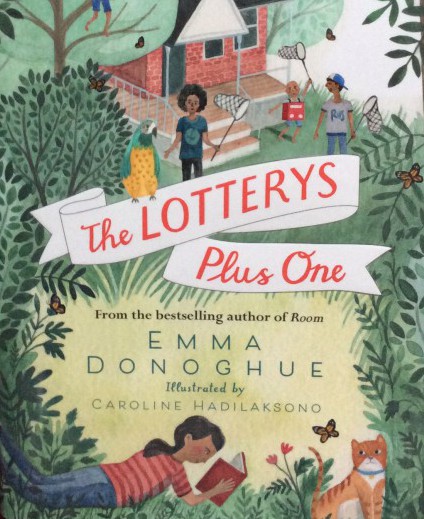Inspiring Young Readers
 posted on 19 Jul 2017
posted on 19 Jul 2017
The Lotterys Plus One by Emma Donoghue
This debut children’s novel is by the bestselling author of Room, a book that was unusual because it convincingly used the voice of a very young child as narrator. He told the strange story about how he and his mother lived their narrow life as defined by the abusive father who imprisoned them in one room for the first four years of his life. Not a happy family by any means although the relationship described between the mother and child is tender, fiercely protective and special despite the awful circumstances.
Here we have a very different portrait of family life but again one that is unorthodox and possibly ground breaking in children’s books. The story is set in Canada, where Donoghue now lives, and describes how a granddad with dementia comes to live with his extended family because he is no longer able to safely look after himself. It is a transition that proves to be very disruptive for all concerned. The dynamics of the multicultural Lottery family (so called because they won a huge amount of money in a lottery) are already rather complicated. It consists of two same sex mothers known as Maxi Mum and Carda Mum, two same sex fathers, known as Papa Dum and Pop Corn plus seven children aged between one and sixteen, some adopted. It was very useful to have a family portrait at the beginning of the book to help keep track of everybody. Most of the children are also named after trees which for some reason really annoyed me. When I started reading the book I had a little voice that kept saying ‘She is trying too hard here to be right on - I don’t believe such a family would ever exist …’. Several times I found myself agreeing with granddad for instance when he exclaims ‘Very hippy-dippy’’ with something that could be a snort or a sniff’. Despite his developing dementia, he continues to acts as the voice of reason as he questions some of their lifestyle decisions.
This is an idealised family in many ways, and there is nothing wrong with that. The four parents are understanding, empathetic and usually good tempered. There is time and patience for the children to pursue unusual hobbies and interests and they share out household chores, making most decisions democratically. The children are home schooled which gives them a lot of space and scope. They also live in a huge house with designated areas for creative projects and music and all the children have their own rooms on which they have stamped their personalities. That is until the grandfather appears on the scene and nine year old Sumac, the central character, has to give him her bedroom because it is on the ground floor. She has so far been painted as a feisty girl who is regarded by the rest of the family as being mature, curious, bookish and trustworthy for her age, with a current fervent interest in learning about Ancient Mesopotamia. But giving up her bedroom is the point at which she shows an entirely believable reaction, because she is not at all happy. She makes it her mission to convince the rest of the family that he would be much better placed in a residential care home.
Despite my early misgivings, I started to warm to this unusual family after a few chapters and think that Donoghue has managed to cover some very interesting themes plus plenty of drama along the way. The characters are vibrant and flawed in a believable way and beneath the surface there are plenty of hormones and jealousies as in any family. The plentiful illustrations by Caroline Hadilaksono add a welcome dimension to the texture of this very likeable book which I would strongly recommend to those readers who enjoy getting to know fictional characters in a series of stories – there is a sequel on its way and I would imagine that there will be plenty more to follow.
Karen Argent
July 2017